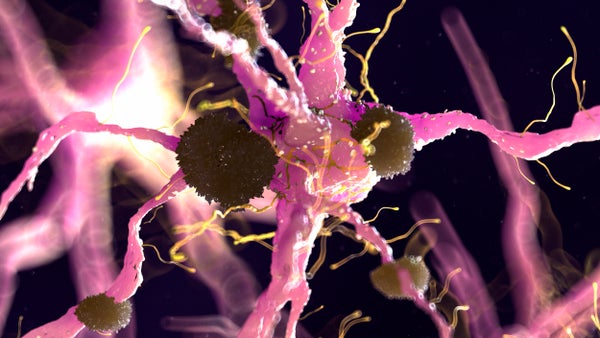This article was published in Scientific American’s former blog network and reflects the views of the author, not necessarily those of Scientific American
The Alzheimer’s Association estimates that more than 5.8 million Americans have Alzheimer’s disease, a number that will double by 2040 and cost $1 trillion per year by 2050. Currently, there are no therapies to prevent or stop the progression of Alzheimer’s once it develops. This dire situation needs a solution.
Hundreds of millions of dollars have been spent developing and testing drugs by the major pharmaceutical players including Eli Lilly, Pfizer, Merck and Roche. Each of these programs has failed in a highly public and spectacular fashion.
The most recent case came last month when Biogen’s aducanumab failed in a phase III clinical trial, a drug candidate that was thought to be the best-of-breed. These failures disappoint patients, their families, biopharma and investors. What went wrong?
On supporting science journalism
If you're enjoying this article, consider supporting our award-winning journalism by subscribing. By purchasing a subscription you are helping to ensure the future of impactful stories about the discoveries and ideas shaping our world today.
Most of the major drug candidates for the treatment of Alzheimer’s was developed based on a theory that became known as the amyloid hypothesis. Beta amyloid is a protein that was discovered by Alois Alzheimer in 1906. According to this hypothesis, the accumulation of beta amyloid in the brain is the primary cause of the disease. While each drug candidate was slightly different, each of them attacked beta amyloid, under the assumption that eliminating the protein would treat Alzheimer’s. All of them.
Having spent a decade drilling what turned out to be a dry hole, what have we learned? The most obvious lesson is that therapies targeting beta amyloid will not treat Alzheimer’s disease. There are two other important lessons that apply to Alzheimer’s disease drug development and beyond. First, be careful of convergence. That is, when everyone starts thinking the same way, start asking yourself why. Either it is an established fact or people find it too risky to question the status quo and think “outside the box.”
In the case of the amyloid hypothesis, it was the latter. Researchers and drug development professionals were rewarded by hewing to the amyloid approach and punished for innovative thinking. This happened at all levels of funding—the federal government, academia, foundations and industry.
The second lesson is to always ask the question: why am I wrong? Great researchers and great clinicians approach every problem in the same way. How do the facts fit the problem, what is the solution and why is my conclusion wrong? The willingness to question and double check your conclusions, to desperately prove that you are wrong, is what makes for great scientists and clinicians.
In my previous life as a transplant surgeon, I constantly lived with that voice in my head that asked “Why is your diagnosis wrong, what are you missing?” That little voice made me a better doctor.
It is unclear exactly how the amyloid hypothesis became the dominant theory. Professor Alzheimer’s initial description of the protein was simply an observation. By the late 1980s and early 1990s, the discovery of a genetic link between beta amyloid and Alzheimer’s led to the assumption that beta amyloid was the cause of Alzheimer’s disease.
Amyloid went from being a biomarker of the disease to the cause of the disease. It became a fact even though the data was lacking. These misconceptions continued—even the animal models of Alzheimer’s used to back this hypothesis were inherently flawed; the mice were engineered to overexpress beta amyloid.
The dominance of the amyloid hypothesis caused alternative ideas to be ignored. In retrospect, it appears that confidence was misplaced. The failure of recent trials focused on the amyloid hypothesis, however, has opened doors for new approaches to Alzheimer’s treatment.
One of the leading ideas is that Alzheimer’s is an immunologic disease caused by neuroinflammation. Neuroinflammation is chronic inflammation of the brain, a sustained abnormal immune response that is detrimental to the brain. Neuroinflammation is caused by specialized immune cells that reside in the brain, called microglial cells.
Activated microglial cells secrete proteins that kill nerve cells and cause the nerve cells to stop communicating with each other—called synaptic dysfunction. Fewer brain cells and poor communication between the brain cells cause the cognitive decline that is the hallmark of Alzheimer’s. Animal studies show that turning off the microglial cells decreases neuroinflammation to allow the brain’s nerve cells to survive and thrive.
Patients with diabetes, who smoke or have chronic inflammatory diseases such as rheumatoid arthritis have an increased risk of Alzheimer’s. The biggest risk of Alzheimer’s is aging—and aging causes chronic inflammation. Chronic inflammation does not originate in the brain. That is, peripheral inflammation causes central inflammation. One of the big new ideas in addressing Alzheimer’s is to treat peripheral chronic inflammation to prevent neuroinflammation.
Currently, no drugs are approved to treat neuroinflammation, but there are several in development and undergoing clinical trials. Our drug candidate XPro1595 targets chronic inflammation to treat Alzheimer’s and is currently undergoing phase I clinical trials. Other examples of drugs in development to treat inflammation in Alzheimer’s patients are NP001 and GC021109; each has its own unique approach.
The reality is, there will likely be more than one effective treatment for Alzheimer’s. They will only be discovered, developed and brought to market when we innovate, when we take chances—not with patients’ lives, but with our ideas. We must be prepared to be wrong—for every right idea, there are dozens of wrong ones. And the faster we get there—the faster we faithfully follow the data—the sooner we can start helping patients. And making a difference at the bedside is the only thing that matters.
